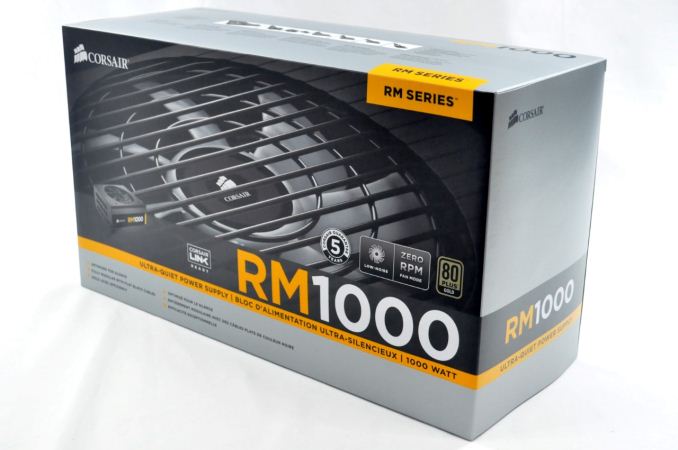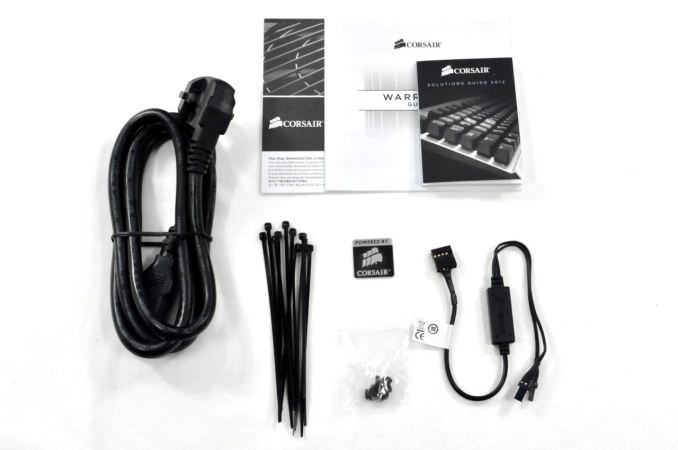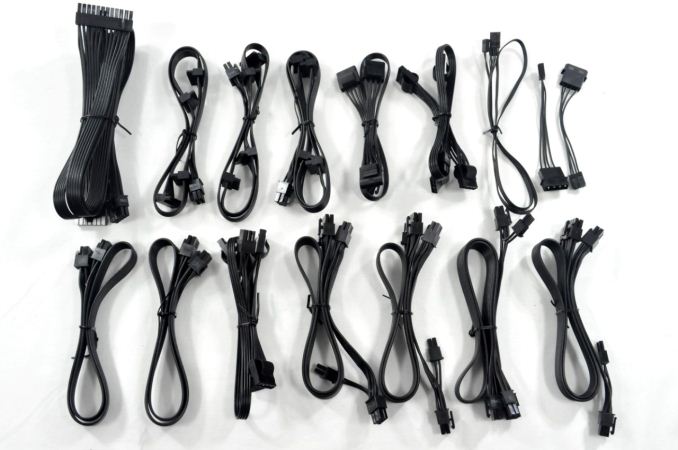Corsair RM1000 Power Supply Review
by E. Fylladitakis on April 24, 2014 6:00 AM EST- Posted in
- Cases/Cooling/PSUs
- Corsair
- PSUs
- RM Series

Introduction
Corsair has created a good reputation for their branded PSUs, and today they are among the most popular choices for gamers and enthusiasts. The first PSU from Corsair to find its way into our new testing lab is the RM1000, an 80 Plus Gold Certified unit with a rated output of 1000W at 40°C ambient. Given the rated power output and retail price of $169.99 after rebate, the RM1000 is understandably targeted at advanced users and gamers, and very few PCs require so much power. The target audience can be quite demanding, however, and a simple 80 Plus Gold certification is not enough to entice such users, so let's see what else Corsair has up their sleeves.
The RM series PSUs are optimized for silence and there are currently six models, ranging from 450W to 1000W. That makes the RM1000 the most powerful model of the series but it also is significantly different from the less powerful models as well. In fact, it's almost entirely different. The 750W and the 850W models come from a different ODM, as they are based off of Chicony Electronics designs, while Channel Well Technologies (CWT) supplies the other four models. As such, the RM1000 and the RM450/RM550/RM650 are all based on a CWT design, yet the RM1000 we're looking at is based on a different platform than that of the lower wattage models.
Corsair has had many CWT derived designs in the past and most of them were very popular among advanced users. However, times have changed and there is stiff competition in the market right now, especially in this particular segment, as every single manufacturer apparently wants a high performance 1000W model as their halo product, and the market has been virtually flooded with such PSUs. Not surprisingly, it's no longer possible to compete at the top of the market by simply offering a "high performance" PSU. Let's have a thorough look at the RM1000 and see what it can offer to consumers and where it falls short.
Packaging and bundle
We received the Corsair RM1000 inside a large, interestingly designed cardboard box. Most of the box is grey with yellow colored accents, the series' trademark. The front and sides of the box are relatively tidy, with badges and summarized descriptions of the most important features. The rear of the box offers a wealth of information regarding the performance of the power supply, summarized in charts and a table rather than tons of marketing text.
The Corsair RM1000 bundle is adequate, but it could have been better for a unit of this class. Alongside the power cord, manual and screws, Corsair also supplies a few cable ties, a case badge with the company's logo, a Corsair Link interface cable, and an advertising leaflet.
As this is a high output, fully modular unit, numerous cables are supplied alongside the PSU. All of the cables, including the ATX connector, are black ribbon cables without sleeving. Some will say they look significantly better than sleeved color-coded wires and require less space, though that's a matter of personal preference. while it looks like Corsair chose not to include a bag for the extra cables, the body of the unit itself comes wrapped inside a pouch for protection during shipping, and this pouch can be used to store the cables later on.














55 Comments
View All Comments
piroroadkill - Thursday, April 24, 2014 - link
Solid enough, but personally I have no love for Channel Well Technology.Streetwind - Friday, April 25, 2014 - link
Bit of a shortsighted notion... CWT is an OEM, they manufacture in exactly those quality levels that their customers request. If a customer asks for a cheap piece of crap, the OEM will produce them a cheap piece of crap. But if Corsair says that they need a high quality product, CWT builds them a high quality product. PSU production is not rocket science; it's all about how many corners you're willing to cut to drive the price down.dirtyferret - Thursday, April 24, 2014 - link
I've owned two CWT PSU and 5-6 seasonic OEM units. Maybe I was lucky but I never had any issue with the CWT units I have owned with both working well for 5+ years. I did get an antec (seasonic oem) with a bad coil, my other seasonic PSU never had an issue.tech6 - Thursday, April 24, 2014 - link
With CPUs and GPUs becoming more efficient there really is a very small market for 1kW PSUs. Even with dedicated mid-range gaming graphics cards, a lot of new PC never exceed 350W. I wish PSU makers would put as much effort into efficient and quiet low wattage products as they do with overkill products like these.2late2die - Thursday, April 24, 2014 - link
Well to be fair the entire RM line is geared towards quiet and efficient operation, so if you want that with low wattage just get the 450W unit. Of course 1kW units are geared towards the smaller enthusiast market, always have been and probably will always be. With that being said, if you want to build a powerful system (not necessarily cutting edge, but above mid-range) and keep quiet, then you want the 850W or 1kW unit because of the whole "no fan below 40%" thing. Like you said, many systems, even at load might not reach 40%, which just means that your 1kW unit will always work completely silently, so that's one less fan for you to worry about.Daniel Egger - Thursday, April 24, 2014 - link
That doesn't make sense. A high output unit will almost always have a higher loss and thus emit more heat. In other words: it's actually easier to produce a fanless 400W unit than to produce a 1000W unit that runs with a fan at 0 RPM below 400W.PEJUman - Thursday, April 24, 2014 - link
^^not exactly, you're correct for PSUs from 10 years ago, however the 80 certification requirements forces the modern PSU design to be efficient at all loads:the 80 gold requirements: min efficiency @ 20% load = 0.87, 50% load at = 0.9, 100% load = 0.87
Therefore a 450W 80 Gold will only be 3% (6 Watts) more efficient than a 1000W 80 gold at 200W load.
Daniel Egger - Friday, April 25, 2014 - link
My point is this: If you want to build a system designed for 400W max output it does *not* make sense to use a 1000W just because it happens to run at 0RPM below 40% utilisation.BTW: Not sure your what you meant by "you're correct for PSUs from 10 years ago" because your own calculation proves that I'm still correct for current PSUs. 6W are nothing to sneeze especially considering that no decent system has an idle load of 200W, not even an unlocked haswell setup with crossfire r9 295x2 cf. http://www.anandtech.com/show/7930/the-amd-radeon-... (which this PSU couldn't drive anyway) and those figures are going to be much worse for sane setups.
owan - Friday, June 27, 2014 - link
He didn't say at Idle, he said 200W load. Considering that PSU's are most efficient at 50% load, it actually makes some sense to size your PSU to keep the max load closer to 50% than 100%, particularly if you run your system at high loads for a high percentage of its uptime (i.e. long rendering times, long gaming sessions with minimal other usage) With a high end system drawing well over 500W from the wall, a 1000W PSU is a perfectly sane choiceUnknownZA - Thursday, August 20, 2015 - link
The problem is that new GPU's like Maxw ell do draw more power. A normal 980 GTX Ti apparently only draws 250W which is excellent. However, most if not all of the overclocked 980 GTX Ti's that are on the market draw much more power.I have a GALAX 980 GTX Ti HOF and under full load it draws close to 480W.
I currently have a Corsair TX 750W which I thought was more than enough power for my system, currently Z68 with 2600K, but bought a 4790K and Z97 too. However I have had quite a few crashes while playing games and I have come to the conclusion that the PSU is not suppling enough power. So I am looking at this 1000W Corsair RM. I could go with the 850 but the price difference is negligible.